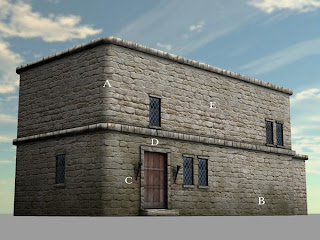This tutorial will show how I created the arched doorway that fits the four way vault. To work through this tutorial, you'll need to have the completed the four way vault modeled in this tutorial:
http://3dmedieval.blogspot.com/2010/12/modeling-low-poly-medieval-arch.html
Step 1: Open up the vault model, enter front view, and add a circle (default 32 vert).
Step 2: Using the 4 way vault as a reference, re-size the circle like this:
The verts in the horizontal center of the circle should line up with the top of the vault column, as in the picture above. The top center vert of the circle will not line up with the center of the arch, as we are making a gothic, or "pointed" arch. It's ok if things are not precise at this point. You can tweak things in the next few steps.
Step 3: Select all the verts, and extrude the size (E - S). Be sure that the inner circle clears the base of the four way vault as shown. In the image at the very top of this tut, I made the arch clear the base more than I did in this tutorial. This is just a matter of personal preference. Size your as you like.
Step 4: Select the verts shown and delete them.
You should end up with this:
Step 5: Duplicate all the verts and flip them horizontally. Line up the two arches as shown.
Step 6: Select all the verts, and re-center as shown.
Step 7: Merge these two verts:
Select the two top verts, subdivide, then move the newly created vert into position to complete the arch. Make new faces as shown.
Step 8: Select the verts shown, and extrude down as shown.
Step 9: Enter top view, select all the verts, and extrude as shown. In this case, I extruded .5 Blender units. This is a matter of personal preference, and of course the thickness can be modified later.
Step 10: The modeling of the arch is complete. To finish it up, make sure all the face normals are pointing outward, set it smooth, and add an edge split modifier (default settings are fine). Don't apply the edge split mod, as it doubles the verts for some reason. You should end up with this:
That's it. If it serves your purpose, you can remove some unnecessary faces, as shown. These will not be visible from inside the vault.
At this point, you should have a four way vault, a straight hall section and an arch, which should all connect together nicely. It the next tutorial, I'll explain how to model a cap wall and a door.









































